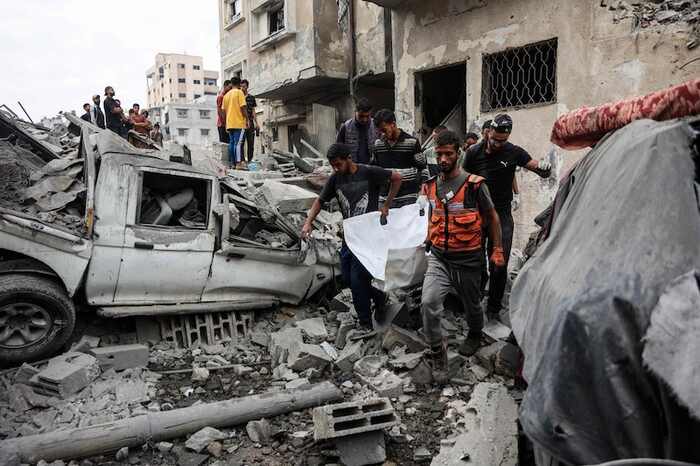Deadly Night in Gaza Amid Claims of a Ceasefire
More than 100 Palestinians were killed in Gaza overnight as Israeli forces carried out heavy airstrikes, marking one of the deadliest nights since the October 10 truce took effect.
The bombardment came as U.S. President Donald Trump insisted the ceasefire remains intact, even as international observers warned it could collapse entirely.
According to Gaza’s Health Ministry, at least 104 people were killed, including women and children, in a wave of attacks targeting multiple residential neighborhoods. Hospitals across Gaza reported overwhelming casualties, with emergency teams working through the night to rescue survivors trapped under debris.
Witnesses described the bombings as “apocalyptic,” with homes, schools, and makeshift shelters completely destroyed. “We were sleeping when the whole building shook,” said Mahmoud El-Khatib, a Gaza resident. “It felt like the end of the world.”
Israel Says Strikes Were in Response to Truce Violations
The Israeli military confirmed it had carried out the air raids, claiming they were in response to alleged violations of the ceasefire by Hamas. Officials said one key trigger was the return of an Israeli hostage’s remains, which the government claimed were tampered with — a move it called “a clear breach of the truce terms.”
While the Israeli Defense Forces (IDF) said the strikes were “limited and targeted,” the resulting civilian toll suggests otherwise. Gaza officials reported that entire families were wiped out, and some of the dead were sheltering in tents after being displaced from earlier bombings.
Critics say Israel’s actions could unravel the fragile peace deal brokered earlier this month. The truce, mediated by Malaysia and Egypt under ASEAN’s diplomatic efforts, was designed to halt months of bloodshed and open pathways for humanitarian aid.
Trump’s Role: Balancing Peace and Power
U.S. President Donald Trump, who has been positioning himself as a global peace negotiator, downplayed the overnight strikes. Speaking to reporters before his flight to Japan, Trump said, “Nothing will jeopardize the truce. Israel has a right to defend itself, and peace remains our priority.”
Trump’s administration has claimed credit for brokering temporary peace between Thailand and Cambodia earlier this week, and the President has since been eager to showcase similar success in the Middle East.
However, many analysts say Washington’s messaging — supporting both a ceasefire and Israel’s right to retaliate — risks deepening confusion about the U.S. stance.
“Trump’s diplomacy is a mix of showmanship and pressure politics,” said Dr. Joseph Liow, dean at the Lee Kuan Yew School of Public Policy. “The U.S. wants to appear as a peace broker, but these airstrikes highlight just how shaky that claim is.”
Gaza’s Humanitarian Crisis Deepens
The human cost of the latest assault has reignited global outrage over Gaza’s deteriorating humanitarian situation. Hospitals are running out of medical supplies, power shortages are rampant, and food distribution has been disrupted due to damaged infrastructure.
Aid groups, including the International Committee of the Red Cross (ICRC), condemned the strikes and called for immediate restraint from both sides. “The people of Gaza are already living on the edge. Every new explosion pushes them closer to catastrophe,” said a spokesperson.
Local NGOs estimate that more than 60,000 people have been displaced since the conflict reignited earlier this year, and many are living in temporary shelters near border zones.
A Fragile Truce Under Fire
The renewed violence has raised doubts about the viability of the ceasefire, which had been widely hailed as a breakthrough in U.S.-mediated diplomacy.
Under the agreement, both Israel and Hamas were to suspend military operations while talks continued toward a longer-term peace framework.
However, analysts argue that the deal lacked clear enforcement mechanisms and left too much room for interpretation. “This was always a ceasefire in name only,” said Middle East analyst Huong Le Thu from the International Crisis Group. “Without an independent monitoring body, it was bound to fail.”
Global Response: Condemnation and Concern
Reactions poured in from around the world. The European Union urged “maximum restraint” from both sides, while UN Secretary-General António Guterres expressed deep concern over the mounting civilian death toll.
China and Brazil, both present at recent ASEAN peace discussions, called for immediate cessation of hostilities and a return to dialogue.
Despite growing international pressure, Israel maintained that it had acted in self-defense and that Hamas’s alleged violations “left no choice but to respond.”
The Bigger Picture: What’s Next for Gaza?
With more than 20,000 casualties since the beginning of the conflict, Gaza’s long-term recovery seems uncertain. The destruction of infrastructure, coupled with ongoing political divisions, threatens to plunge the region deeper into instability.
Trump’s upcoming meeting with Chinese President Xi Jinping at the Asia-Pacific Economic Cooperation (APEC) summit could further shape the next phase of peace efforts, particularly if Washington seeks a coordinated international response.
However, for the people on the ground, the focus remains survival. As one Gaza doctor put it: “We don’t care about diplomacy anymore. We just want the bombing to stop.”
A Ceasefire in Name Only
While the White House continues to promote the truce as a sign of progress, the bloodshed in Gaza tells a different story.
The deaths of more than 100 civilians highlight not only the fragility of the ceasefire but also the complex web of politics, power, and diplomacy that underpins it.
For now, the so-called “peace” remains as uncertain as ever — with the world watching to see whether it can hold, or whether another devastating chapter in Gaza’s history is about to unfold.
Source: ALJAZEERA.com


